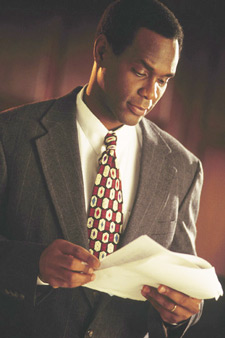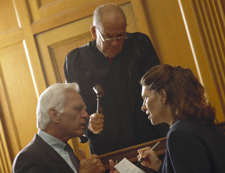Home | Glossary | Resources | Help | Contact Us | Course Map
Archival Notice
This is an archive page that is no longer being updated. It may contain outdated information and links may no longer function as originally intended.
Pretrial Preparation
The failure to prepare adequately for courtroom testimony can lead to disaster. Pretrial preparation begins upon receipt of the case. Ensuring that complete, accurate, and legible case file notes are documented will dramatically reduce the amount of pretrial preparation required and, most likely, the amount of time that the witness will remain on the stand.
Prior to giving any testimony the examiner should thoroughly review the entire case file along with any source or reference material contained in the case. The examiner should be prepared to answer questions about their laboratory standard operating procedure, proficiency testing, accreditation, and literature in the field that directly relates to the testing performed in the instant case.
Given the large body of literature in the field of firearm and toolmark identification, it would be impractical to know of every article, study, or text that addresses the subject. When confronted with an unfamiliar piece of scientific literature, one possible and not unreasonable response could be I am not certain about the piece that you are referring to. However, if you have a copy, I would be happy to take a look at it. Special note should be made that the response did nothing more than offer to look at the piece. It did not indicate that you could adequately digest and apply the substance to any further questions.
Additionally, the examiner should schedule a time to meet with the attorney and review the case file and test results. Do not expect the attorney to be fully versed in your field of expertise or know what questions he or she should ask. Additionally, the examiner should assist the attorney in the preparation of any exhibits or demonstrative aids that the witness expects to use. This entails not only the graphical presentation, but ensuring that the content is accurate. If using electronic methods such as PowerPoint, slides, videos, images, etc., you should practice and be prepared to use the media during trial. Witnesses must also be prepared for the worst case scenario during trial. For example, the witness should always have a backup method ready for use in the event of an unexpected technical problem.
Appearance
The manner in which examiners dress and carry themselves in the courtroom will speak volumes about them, their agency, professionalism, quality of work, and self-confidence. Appearing too casual or sloppily dressed can be seen as a weakness in these areas as well as infer a level of disrespect to the proceedings. Likewise, overdoing it can be perceived as arrogant and condescending. Either extreme is distracting and can easily be used to support or undermine the quality of an analysts work. Appearance should also be understood to include gait, posture, and eye contact.
Courtrooms are traditional and conservative environments and not necessarily the best place to exhibit the most current fashion trends or styles. Witnesses should not wear excessive or gaudy jewelry or accessories. The miniskirt, extrawide (or narrow) tie, nose or lip piercings, and multiple ear piercings are better left at home.
Unless mandated by agency policy, use of any uniform as court attire is normally discouraged. A business suit is more appropriate. A suit lends itself to objectivity and is a convention normally associated with professionals. Defense counsel can easily project the witness in uniform as nothing more than an extension of the law enforcement agency and thus the results are predictable and not objective.
Demeanor
Professionalism, competency, objectivity, and integrity: these are the concepts that should come to mind when considering the appropriate demeanor to exhibit in court proceedings. Maintaining the integrity of the individual as well as the science involved is critical. Yes, sir, no, sir, yes, Your Honor, no, Your Honor, and the like are entirely appropriate.
Handling the Aggressive Attorney
Circumstances will certainly arise that will tempt the examiner to enter into a debate or confrontation with the attorney. There are more effective methods to deal with attorneys who create such circumstances. It is important to remember that the attorney may be doing nothing more than intentionally trying to confuse or agitate the examiner during their testimony. The strategy has less to do with the substance of the testimony and more to do with demeanor and presentation to the jury.
Do
- remain professional and composed,
- remain objective,
- use volume and tone to deflect hostility,
- explain answers, if necessary.
Don't
- become agitated or argumentative,
- permit the attorney to put words into your mouth,
- become personally invested in the case or its outcome.
Presentation Skills
Presentation skills are difficult for an examiner to master. The ability to balance the highly technical field of expertise while ensuring the jury comprehends the content is not as easy as one would initially think. It is easy for the testimony to become overly technical and scientific, well beyond the grasp of the jury's ability to understand. Conversely, it is equally easy to oversimplify the subject matter and become condescending or insulting to the jury. Witnesses should remember to enunciate clearly and loudly enough to be heard by the jury. Always check with the attorney to get an idea of the jury composition and education level. Remember that the most precise, technically correct, and jargon-laden statement doesn't mean anything if the jury doesn't understand it correctly. The examiner should double check any materials that they expect to use in their presentation for accuracy and clarity.
Conclusions
The ability to communicate effectively in court can be difficult and intimidating, yet it is a critical aspect of the examiners responsibilities. Of equal importance is remaining objective and professional during the process of giving testimony. Properly preparing for court is an obligation that will result not only in the examiners ability to give accurate testimony, but will also deflect the efforts of an aggressive attorney. Professionalism, competency, objectivity, and integrity are the landmark components to effective courtroom testimony. Shortcomings in any of these components may lead to potential ammunition for attack by attorneys.
Selected Bibliography
The Selected Bibliography is a list of the writings that have been used in the assemblage of the training program and is not a complete record of all the works and sources consulted. It is a compilation of the substance and range of readings and extensive experience of the subject matter experts.
- Keierleber, M, and T. Bohan. 2005. Ten years after Daubert : The status of states. JForensic Sci 50 (5): 115463.
- Schmalleger, F, 1999. Criminal Justice Today: An Introductory Text for the 21st Century , 5th ed. Lebanon: Prentice Hall, Inc.
Additional Online Courses
- What Every First Responding Officer Should Know About DNA Evidence
- Collecting DNA Evidence at Property Crime Scenes
- DNA – A Prosecutor’s Practice Notebook
- Crime Scene and DNA Basics
- Laboratory Safety Programs
- DNA Amplification
- Population Genetics and Statistics
- Non-STR DNA Markers: SNPs, Y-STRs, LCN and mtDNA
- Firearms Examiner Training
- Forensic DNA Education for Law Enforcement Decisionmakers
- What Every Investigator and Evidence Technician Should Know About DNA Evidence
- Principles of Forensic DNA for Officers of the Court
- Law 101: Legal Guide for the Forensic Expert
- Laboratory Orientation and Testing of Body Fluids and Tissues
- DNA Extraction and Quantitation
- STR Data Analysis and Interpretation
- Communication Skills, Report Writing, and Courtroom Testimony
- Español for Law Enforcement
- Amplified DNA Product Separation for Forensic Analysts




